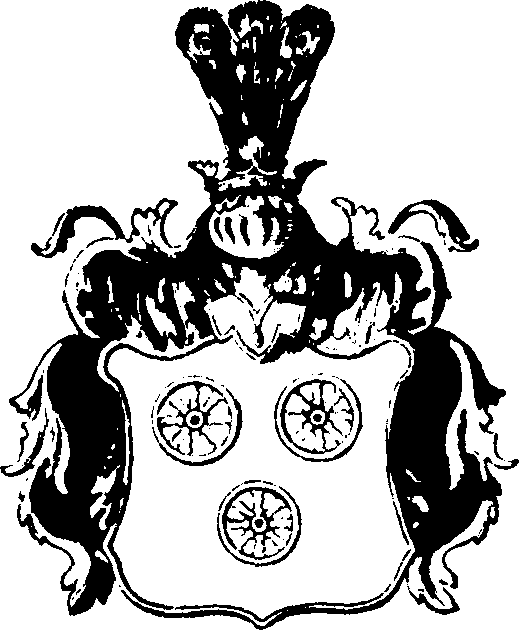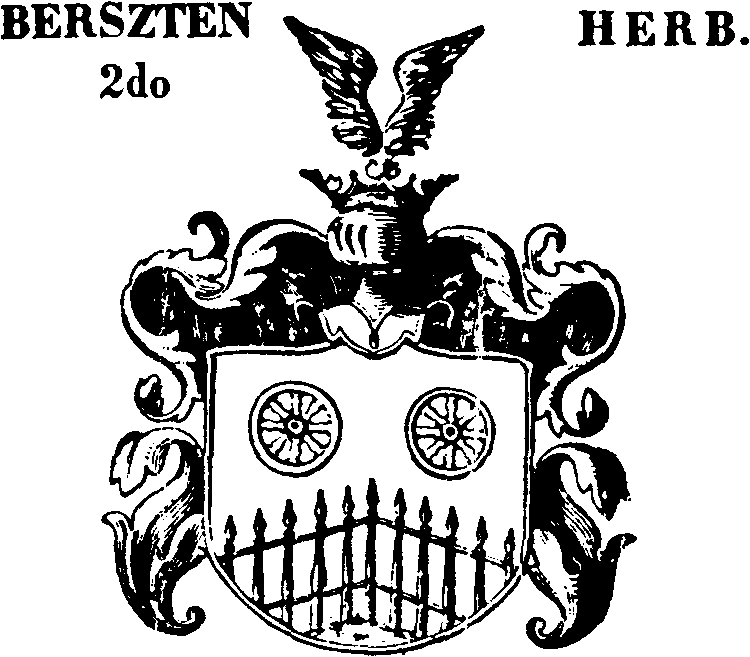Herb Berszten
Research Heraldry Herb Berszten
Herbarz Polski translation
Berszten herb
 The following article is a direct translation from the classic Genealogical and Heraldic reference "Herbarz Polski" by Kasper Niesiecki S.J., (Lipsk) edition 1839-46.
The following article is a direct translation from the classic Genealogical and Heraldic reference "Herbarz Polski" by Kasper Niesiecki S.J., (Lipsk) edition 1839-46.
Three yellow wheels are arranged in a field of red, with two above the one in the middle. Three peacock feathers stand above the crowned helmet. Many families in Europe have wheels in their coats-of-arms. Some have one; others, four. I have not seen any with three. Our writers state that this coat-of-arms came from Germany, as the name Berszten would indicate, but none gives the period of its arrival. To the two families that they list, KARNIOWSKI and WIERZCHLEJSKI, I add GASZYNSKI. These latter two have changed the form somewhat, to BERSZTEN II Coat-of-Arms. Two wheels are arranged as on the coat-of-arms above, in the same colors. However, instead of a third wheel, there is a picket fence, like that surrounding a fortress. Two wings in flight formation are above the helmet.
My guess is that this change occurred in 1563 during the reign of Zygmunt August, when Prince Ivan Wasilewicz of Moscow lay siege to Polock. Many quickly turned themselves over to the enemy, but WIERZCHLEJSKI, Captain of the Polish cavalry, resisted bravely for a long time before surrendering after extensive negotiations. Out of gratitude and admiration for his courage, the enemy feasted Wierzchlejski and his Poles, presented them with gifts, and set them free. I surmise that Wierzchlejski received the change in his coat-of-arms upon his return to the King.
Copyright © 1984 Josephine M. Piegzik. Used by permission. This article originally appeared in Polish Genealogical Society Newsletter (Vol. 6, No. 2, Fall 1984), the journal of the Polish Genealogical Society (of America).
Berszten (II) herb
 The following article is a direct translation from the classic Genealogical and Heraldic reference "Herbarz Polski" by Kasper Niesiecki S.J., (Lipsk) edition 1839-46.
The following article is a direct translation from the classic Genealogical and Heraldic reference "Herbarz Polski" by Kasper Niesiecki S.J., (Lipsk) edition 1839-46.
Neither Paprocki nor Okolski wrote about this coat of arms. There are two plow wheels, as in the first Berszten coat of arms. Instead of the third wheel there is a fence similar to those found at fortifications. There are two wings above the helmet, back to back and raised up in flight. The change was made here in Poland during the time of Zygmunt August in 1563. When Iwan Wasilewicz, Prince of Moscow laid siege to Polock, some were frightened by the shooting and the pressure and surrendered to the Czar. Wierzcheleski, the Polish captain from Sleza and of the coat of arms of Berszten bravely and at length resisted the enemy's force. After being exhausted and running out of ammunition they gave the city over to the Czar. Those who were the first to leave the city were imprisoned despite the promise that this would not happen. Wierzcheleski and his men however were generously pardoned and set free. (Bielski page 613). Wierzcheleski, upon returning to the king, it is thought, received the change in the coat of arms.
Copyright © 1985 Josephine M. Piegzik. Used by permission. This article originally appeared in Polish Genealogical Society Newsletter (Vol. 7, No. 1, Spring 1985), the journal of the Polish Genealogical Society.
;
